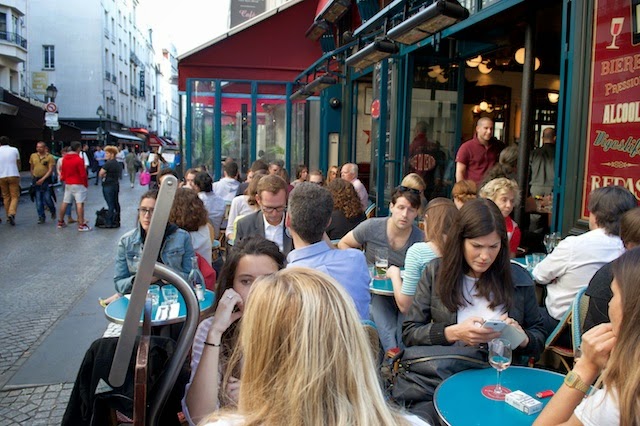(Our blog is longer and later today because of the events of
the day.)
Today is the story of two epic battles, staged about twenty
miles apart and separated by 878 years, each dividing history into before and
after. The first is known today as the Battle of Hastings in October of 1066.
This was the day that a native of France, known the day before as Guillaume de
Normandy, became known the day after as William the Conqueror, King of England.
The city of Bayeux, situated in “Upper
Normandy”, is known worldwide as the host city of the famous
Bayeux Tapestry. This 70-meter long, 1-meter high piece of embroidery (not
tapestry as we know it today), tells in 57 scenes the why and how of William’s
establishing himself as King of England. I would share with you my own photos
of this stunning piece of handiwork, but photography is forbidden (tell that to
the guy who put his smartphone in video mode and walked the full 70 meters in
record mode, but I digress). Instead of my own photos, I suggest you check this
out for more details than I could provide here: Bayeux Tapestry
Beyond the tapestry, Bayeux is a lovely city to visit and –
guess what? – they have a stunning cathedral.
The cathedral itself provides an architectural segue into
the main subject of the day: D-Day plus 70 years. On this day seventy years ago the largest
invasion in the history of warfare took place, this time in the opposite
direction from that of William the Conqueror, and not for the purpose of
seizing control, but of returning it to its rightful owner. Make no mistake about this: Europe at large,
and France in particular, have not forgotten, nor have they belittled, what
happened on that day. This documentary
movie poster is evidence. The French
title is On a Tous 70 Ans, and in English We are All 70. The message is
plain—the producer wants the French to feel as if their life began anew on
D-Day. There is a certain hyperbole, to be sure, considering that a few hundred
yards away is the Tapestry that tells a slightly different story. But there is
room for multiple points of view.
 I’m afraid I almost started an
international incident. I noticed, as we approached the building and I was
grabbing a few external shots, that flying atop the main spire were the flags
of France, Great Britain, and Australia. The US flag was conspicuous (to me) in
its absence. I guessed (correctly, as it turned out) that this was probably
because that part of the coastline was penetrated by primarily British and
Australian troops, with the American troops landing farther west. But I made
the mistake of picking the wrong person to ask. A sweet gift-shop lady took my question
to mean “doesn’t France understand the
USA was involved too?” even though I was ably assisted
by a bilingual gentleman who offered to help explain my question. She insisted I pay attention to this window,
which clearly includes the American flag in the upper right. The prayer inscribed in the white square at the
bottom, which in English in the window itself, reads:
I’m afraid I almost started an
international incident. I noticed, as we approached the building and I was
grabbing a few external shots, that flying atop the main spire were the flags
of France, Great Britain, and Australia. The US flag was conspicuous (to me) in
its absence. I guessed (correctly, as it turned out) that this was probably
because that part of the coastline was penetrated by primarily British and
Australian troops, with the American troops landing farther west. But I made
the mistake of picking the wrong person to ask. A sweet gift-shop lady took my question
to mean “doesn’t France understand the
USA was involved too?” even though I was ably assisted
by a bilingual gentleman who offered to help explain my question. She insisted I pay attention to this window,
which clearly includes the American flag in the upper right. The prayer inscribed in the white square at the
bottom, which in English in the window itself, reads:
O
Lord my God, when thou givest thy servants to endeavor any great matter, grant
us also to know that it is not the beginning, but the continuing of the same
until it be thoroughly finished which yieldeth the true glory.
We left Bayeux and moved west to Ste. Mere-Eglise. For you
WW II and D-Day history buffs, that’s the first village
liberated on D-Day. The town was immortalized in the film The Longest Day, not only because it was the first, but also
because of what transpired that day. In brief, the paratroopers missed their
landing zone and instead of landing in a nearby field with time to regroup and
attack the village’s defenses, they floated down
into the town square and were met by the German defenders who happened to be on
alert due to a fire in the village. One
soldier’s parachute caught the church bell tower and he hung
suspended, unnoticed by the German defenders, watching in horror as his buddies
were massacred before his eyes. The
event is immortalized today with a reproduction on the bell tower, with real
parachute silk catching the breezes.
One thing we didn’t expect was the
popularity of WW II reenactments not so much by Americans, but by the French
themselves, complete with authentic period uniforms, weapons, and vehicles of
all types. There is a certain cognitive dissonance one experiences walking up
to group of John Wayne-type soldiers speaking fluent French to one another!






.jpg)

































